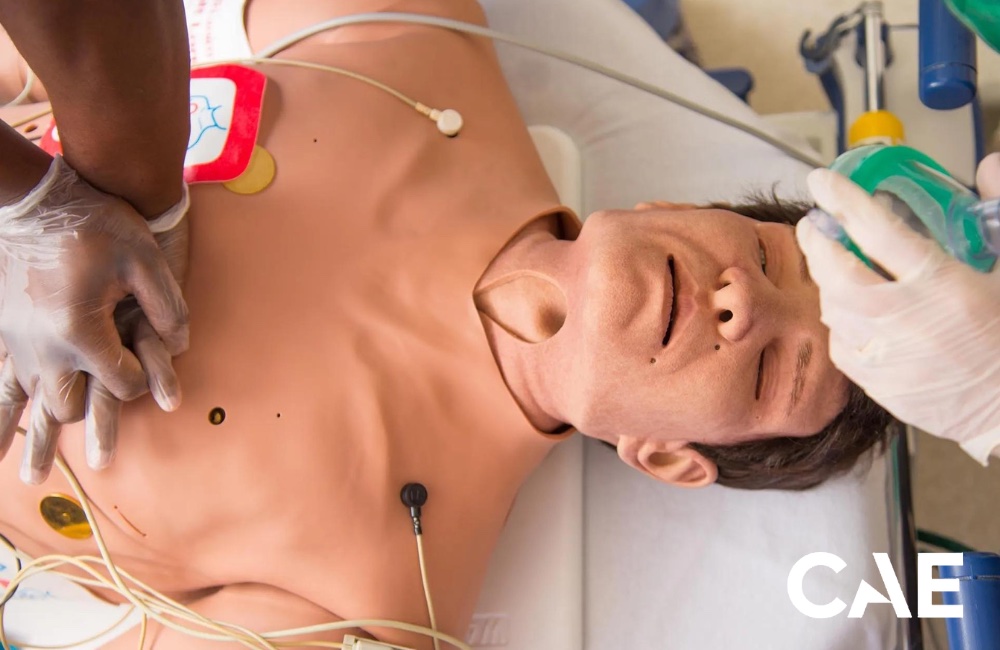Many learners develop a better understanding of practices and procedures by doing them, rather than reading about them or watching others perform them. For these learners, first-hand experience is essential, but a lack of clinical placements and patient privacy complicates that capability. Enter healthcare simulation, which provides a means for them to achieve their clinical hours risk-free. CAE Healthcare has developed a broad portfolio of patient simulators that can be used to improve learners’ preparedness for real-life nursing situations they may later encounter in the field. This HealthySimulation.com article shares the features and benefits of such patient simulators for nursing learners, including CAE Juno and CAE Apollo patient simulators.
In general, a patient simulator is a healthcare simulation resource that mimics human anatomy or function (physiology) and can be used to educate learners and train, healthcare professionals. Also referred to as human patient simulators, they are frequently employed in simulation centers and come in a variety of models, from preterm infant patients to geriatric patients, but also include obstetric birthing simulators, surgical simulators, military simulators, and more – all of which can be used during nursing education.
The CAE line of patient simulators can be used to create immersive learning experiences where participants can practice technical skills, diagnoses, and interprofessional team training for clinical care. Further, CAE Healthcare’s patient simulators come with several lifelike features and responsive automated physiology to help set the standard for high-fidelity realism across clinical education. These features allow nursing learners to develop critical thinking, communication, and clinical skills without posing any risk to real patients.
CAE Healthcare Patient Simulator Examples
Juno: Nursing programs are challenged with preparing new nurses for today’s hospital environment and sicker patients, even as access to clinical hours has diminished. Simulation can help fill the gap by delivering consistent training and helping learners to develop critical thinking skills. Juno, CAE Healthcare’s clinical skills manikin and newest offering for nursing programs, is a modern manikin that was designed to meet educational requirements for clinical nursing skills. These requirements range from task training to advanced patient care scenarios.
Note: There now exists a MultiSim feature for CAE Maestro, the new CAE patient simulation software, that allows instructors to run synchronized simulations on multiple CAE Juno manikins. Learners and educators can increase their operational efficiency by downloading the free latest release of Maestro today!
Mobile and easy to use, CAE Juno offers a contemporary look and feel with a wide range of sounds to create a fully immersive experience for learners. Interchangeable gender increases efficiency and the breadth of experiences. This nursing-focused manikin can sit upright at a full 90-degree angle and features motion in the hips, knees, ankles, shoulders, elbows, and wrists for added realism. With CAE Juno, students can learn to handle a wide range of clinical skills, including suctioning and tracheostomy care, asthma management, gastrointestinal bleeds, and the exacerbation of chronic heart failure.
Apollo: CAE Apollo, an adult patient simulator, boasts a wide range of powerful new features to deliver the ultimate in realistic simulation-based healthcare training. The perfect patient manikin, CAE Apollo is available in two configurations (prehospital and nursing), providing the ultimate versatility and the best value in high-fidelity simulation training.
Note: CAE’s new and improved patient simulation software, CAE Maestro, is also available for Apollo. Featuring the power of CAE Physiology for model-driven simulation and designed with a streamlined interface for instructor-driven scenarios, CAE Maestro is the most comprehensive and user-friendly application of its kind.
Recognized for its versatility and reliability, CAE Apollo features interchangeable genders and realistic patient responses for added flexibility when creating simulation scenarios. Built on a platform that has been field tested by more than 1,600 customers worldwide, CAE Apollo can be used in a wide range of patient care scenarios thanks to its realistic airway and articulation in the neck, shoulders, elbows, arms, and hips. This simulator also features a CPR analysis feature that complies with AHA and ERC guidelines. Use CAE Apollo to learn and practice how to treat anaphylaxis, extreme asthma, a subdural hematoma, or heart failure.
More About CAE Healthcare
CAE Healthcare, a division of Canadian-based CAE, is among the world leaders in developing cutting-edge healthcare simulation learning tools for today’s professional healthcare providers. The company strives to deliver educational tools that best help healthcare professionals provide safe high-quality patient care. CAE Healthcare has an extraordinarily vast area of simulated products ranging from manikins, interventional and imaging systems, and AV recording debriefing / Learning Management Systems.
CAE Healthcare has a unique and wide range of manikins for simulation-based medical education including the Human Patient Simulator (HPS), Apollo (pre-hospital and nursing), Ares (emergency medicine simulator), Juno (nursing skills simulator, Lucina (obstetric simulator), Luna (neonatal simulator), and Aria (pediatric simulator). Most of these high-fidelity medical simulation manikins now run on CAE Healthcare’s patented Maestro software. As one of the original innovators of medical simulation technology, CAE Healthcare has continued to innovate new learning products and solutions that support the world’s healthcare industry.
For example, in addition to a wide range of mid- and high-fidelity simulators, they also provide audiovisual debriefing solutions, such as LearningSpace, their learning management system. They also offer a range of interventional simulators, including CAE CathLabVR, as well as the Vimedix ultrasound simulator, which is one of the few ultrasound simulators to use multiplanar reconstruction and 3D/4D scanning.








